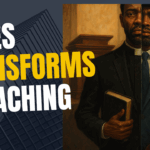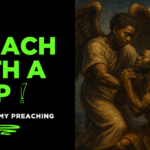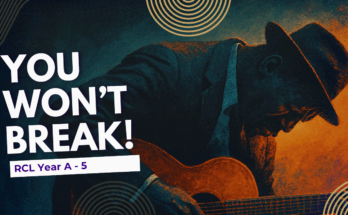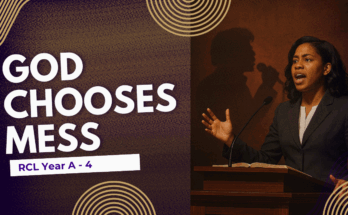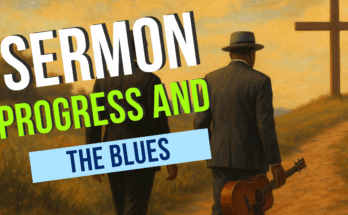As an Amazon Associate I earn from qualifying purchases.
I was listening to Wynton Marsalis recently—one of the great jazz trumpeters of our time—and he broke jazz down into three essential elements. This is my summary of what he said, not his exact words:
- Improvisation – the “I”, your own voice.
- Swing – the “Us”, everybody’s freedom moving together in rhythm.
- The Blues Aesthetic – optimism in the presence of adversity, not naïve but grounded.
The more I thought about it, the more I realized—these aren’t just elements of jazz. They’re elements of blues preaching. They show us how to bring our whole selves to the pulpit, how to preach in rhythm with God’s people, and how to speak hope even when the night is long.
As in jazz, as in the blues, and as in preaching—truth-telling meets community, community meets resilience, and resilience meets hope.
Preaching with the “I”
Improvisation is the “I” in jazz—the moment when your own voice comes alive. And preaching needs that same “I.” You can’t just echo another preacher’s style, cadence, or stories. God called you to preach with the voice He gave you.
“Man, sometimes it takes you a long time to sound like yourself.” — Miles Davis
That’s the struggle—and the joy—of the preacher’s “I.”
But here’s the truth—systems and people will try to make you wear someone else’s armor. 1 Samuel 17:38–40 tells us Saul dressed David in his armor—bronze helmet, coat of armor, sword. David took a few steps and said, “I cannot go in these, because I am not used to them.” So he took them off and picked up his sling and five smooth stones.
That’s not just personal style—that’s resistance. That’s David saying, “I will not fight in a way that doesn’t fit the call God has put on my life.”
Improvisation in preaching is that same faith—knowing the chart of the Word, but bringing your own testimony, your own rhythm, your own tone. Believing, “What God put in me is enough for what’s ahead.”
Preaching with the “Us”
Marsalis says jazz has to swing—and swing is the “Us.” It’s the rhythm of community. It’s freedom expressed in time with others.
Preaching that swings knows the people. It feels their rhythm, hears their amens, and walks with them in both joy and pain. But let’s be honest—community doesn’t always swing. Sometimes the rhythm section is fighting. Sometimes voices get drowned out. Sometimes the groove is broken.
And that’s when the blues itself becomes an act of resistance. B.B. King’s Every Day I Have the Blues isn’t just a lament—it’s a refusal to be silenced. To keep singing every day is to say, “I’m still here.” That’s what it means for a church to keep the groove alive even when times are hard.
Acts 2:42–47 gives us a picture of what happens when the groove is strong. The early church devoted themselves to the apostles’ teaching, to fellowship, to breaking bread, and to prayer. They shared what they had so no one was in need. They worshiped with glad and sincere hearts. That’s swing in the body of Christ—each playing their part, making room for the other, and together creating something bigger than any one could do alone.
Swing in preaching is resisting the urge to solo over everyone else. It’s revolutionary, in a self-centered age, to make space for another’s gift. And when preacher and people lock in together, the groove itself becomes a testimony—a sign of the kingdom breaking in right now.
Preaching with the Hope
The blues aesthetic is optimism in the presence of adversity. It’s the ability to tell the truth about trouble and still sing hope into it.
Life will hand you midnight hours. Paul said it in 2 Corinthians 4:8–9: “We are hard pressed on every side, but not crushed; perplexed, but not in despair; persecuted, but not abandoned; struck down, but not destroyed.”
In Acts 16:22–26, Paul and Silas were beaten, chained, and thrown into the inner cell. Around midnight, they started praying and singing hymns to God. That was not naïve optimism. That was defiance. That was resistance. They were saying to the chains, “You will not have the last word.” And right there, the prison shook, the doors flew open, and the chains fell off.
That’s the blues aesthetic in preaching—you don’t skip the lament, but you don’t stop at the lament either. You tell the truth about the night, but you preach like morning is on the way.
Sam Cooke’s A Change Is Gonna Come captures that same spirit: born from struggle, heavy with lament, but unshakably confident in the promise of a better day. That’s what blues preaching does—it sings “change is gonna come” even while the world still says “not yet.”
Bringing the I, the Us, and the Hope Together
Improvisation keeps the sermon personal—your own voice, like David refusing Saul’s armor.
Swing keeps the sermon communal—moving in rhythm with the people, like the early church in Acts 2.
The blues aesthetic keeps the sermon hopeful—like Paul and Silas singing until the walls shake.
And in each of these, the blues preacher carries the five notes of pentatonic preaching:
- Truth-Telling — Say what’s real.
- Lament — Feel it fully before you move on.
- Memory — Remember God’s faithfulness.
- Resistance — Say “No” to what steals life.
- Hope / The Rise — Proclaim God’s “Yes” breaking in right now.
Lose the “I” and you become a hollow imitation. Lose the “Us” and you become disconnected from the people. Lose the “Hope” and you leave the congregation at a funeral without a resurrection. But when the I, the Us, and the Hope come together—just like in music—the sermon swings with life.
As in jazz, as in the blues, and as in preaching:
You bring your voice.
You listen to the voices around you.
And you keep hope alive, even when the road is rough.
Because in jazz, in the blues, and in preaching—truth-telling meets community, community meets resilience, and resilience meets hope. And that’s how the song goes on.
Amazon and the Amazon logo are trademarks of Amazon.com, Inc, or its affiliates.


